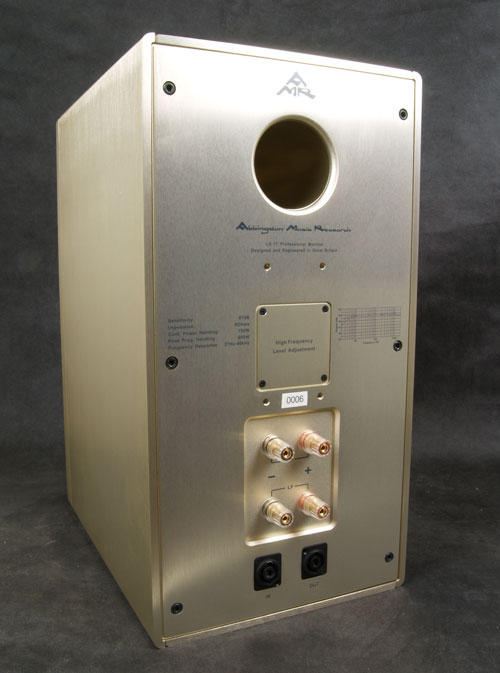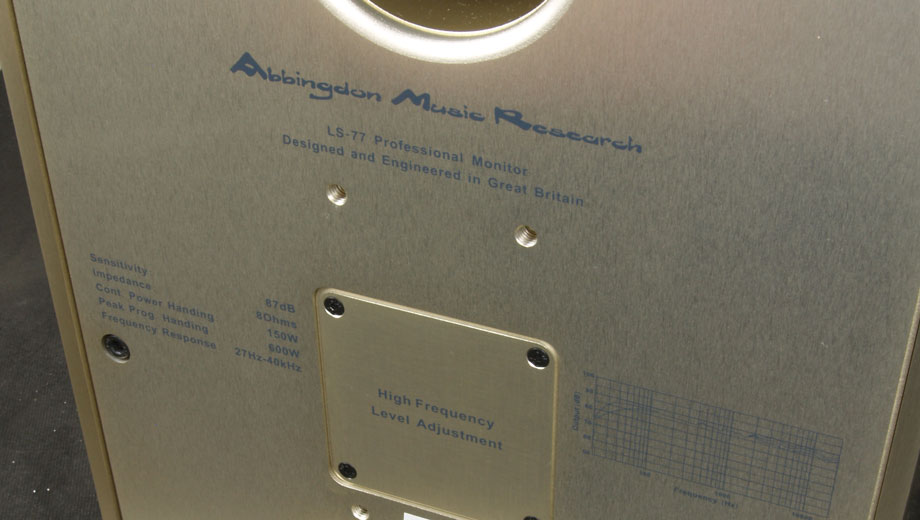Moment of Truth
Both the CDP and amp are plugged in and fired up. The CD-77 wins the 45-second ‘optimising voltage’ countdown which precedes any operation of either component, and I prepare to evaluate just how much work is needed with the LS-77s.
Would you believe it! What greeted me was a beautifully smooth, natural interpretation of ‘Lilac Wine’ by that most under-rated songstress, Miss Elkie Brooks. She then followed up with ‘Pearl’s a Singer’ rather than the bedroom version ‘Pearlz a Zinger’. OK, I’m exaggerating but the human ear/brain interface is fantastically efficient at distinguishing between natural and unnatural, so it doesn’t take much in the way of distortion to push the former into the latter, and conversely it doesn’t take much to push the latter into the former.
My guess is that the combination of a different room, better mains quality, a solid floor, decent rack and the fact I’d unplugged then reconnected every interconnect and speaker cable had caused whatever problem there was to be cured, and that the problem was not actually with the speakers at all. I wasn’t going to mention any of this as once the speakers had shown they were capable of the sweet midrange I’d hoped for, I didn’t want to give anyone cause to question the abilities of the LS-77s. On reflection I decided to include my experiences to show how revealing the LS-77s can be, and that as with many highly resolving speakers aiming for and achieving neutrality, when first installed in your system do not assume that any faults you hear have only just been introduced; they might have only just been revealed.
In the case of the LS-77s, the last few months have proved that while having been conceived and marketed as ‘Reference Class Professional Monitors’ which I’ve no doubt is a job they would be supremely accomplished at, they are also supremely musical devices when combined with supremely musical source and amplification, and have attributes which make them quite unique amongst the competition so far as I’m aware.
For instance, if I told you that my Revel Performa F30s, which now do HT duty, had a frequency response of 33Hz – 16kHz I’m sure you’d accept that was about par for the course, for when it comes to large floorstanders, and when buying the Revels their class leading bass wasn’t a major consideration but definitely did come into the equation.

The most obvious disadvantage is that with cabinet volume and driver size being limited, so is the lower end of the frequency response, which makes the LS-77s ability to extend down to 26Hz just a little impressive, don’t you think? If the Revel’s bass response was about par for the course, the LS-77’s were Tiger Woods on a good day, no wind and a six-foot diameter hole on every green. 26Hz is as deep as one or two of the compact subwoofers I’ve looked at recently to augment the Revel F30s – amazing.
This ability to seemingly defy the accepted law of speaker physics is achieved through the use of a transmission line ‘OptiPort’, and a custom made 10” driver with an extra large 4” voice coil, giving 28mm of displacement. Lots of energy and movement involved, then, so lots of potential for cabinet colouration and vibration; best make the front baffle from aerospace grade magnesium aluminium alloy billet then, and let’s not skimp, make it 25mm thick. Oh, and might as well make the rest of the cabinet from the same alloy – 10mm should do the job nicely. This alloy is also machined to form a transmission line and port which again is far superior to MDF at handling the energy generated and air shifted by that beast of a long-throw driver.
To explain the transmission line in more detail, here’s an excerpt from the speaker’s white paper:
“…the usual bass reflex ports in conventional HiFi speakers tend to work well at low sound pressure levels. Yet the insufficient cross-section and length of these structures usually means that they cannot be tuned sufficiently low to truly extend the low frequency drivers output but instead tend to add more output to the frequency range the low frequency driver already covers while cutting out frequencies below the tuning frequency”
You can appreciate why the 77s are fondly referred to as ‘Baby Rhinos’ at AMR, while I refer to them as ‘The Tyson Twins’ to callers at my place. Such quality of build in a floorstander would mean bringing in a stacker truck for positioning whereas each LS-77s tips the scale at a considerable but manageable 35kg/75lbs. Impressive stuff indeed then, a standmount which can rock the house as well as, and probably better than, most floorstanders with less colouration and better imaging, but that’s only one end of the audio spectrum; what about the other? Unlike the world economy and other world issues, it’s all good news.
In line with AMR’s apparent philosophy of designing from the ground up rather than following the well trodden path, a custom made beauty of a ribbon tweeter sits above the bass, slightly recessed into a flared baffle to aid dispersion. I say ‘ribbon tweeter’ but that’s a slip of the tongue, as conventional ribbons were deemed a little too fragile and possessing too many significant flaws to be used in the LS-77.
Instead, AMR chose to use a customised isoplanar design, and they remind us that the greatly increased surface area of Isoplanars, equivalent to five 28mm domes in this instance, eliminates breakup resonances unavoidable in domes, cones and ring radiating drivers. The result of deviating from convention is a distortion-free treble response up to 40kHz taking it into super-tweeter territory. Well worth the trouble then, so ‘all’ that’s required to achieve the mandated full-range frequency response is to seamlessly join the beauty and the beast together in “Holy” union. Designing a crossover up to the task was achieved by the use of AMR’s OptiSlope technology which resulted in a crossover they claim cuts interference between drivers by 93% when compared to commonly used 1st order designs.
A sackful of new technology and terminology to consider with the LS-77 speakers and the system in general then (I’ve got ‘Opti’ permanently imprinted on the brain), yet having a healthy streak of scepticism, I appreciate that every manufacturer has to face the reality of marketing and will present us with their own selected statistics and specs which claim this, that and the other. Subsequently, I tend not to take too much notice of objective measurements until I’ve heard what the results of those measurements equate to subjectively, and after months of listening the impressive specs on paper do appear to equate to an exceptionally well balanced speaker which would be equally at home in the studio or living room, playing either choral works or Led Zeppelin.
For instance, yesterday saw all seven of my Led Zep CDs played from start to finish while today saw the arrival of their excellent ‘BBC Sessions’ double CD, which is entertaining the neighbours as I write, and once again the sound from the system is as addictive as it has been with almost every disc I’ve thrown at it since the updates; speaking of which…
Version 77.0 vs 77.1
With the 77.1 the following are the improved features:
- Output Coupling capacitors upgraded to highest performance German made tinfoil & film type.
- High tech GOSS Cores for the Mains Transformers.
- Revised digital engine for CD-77
- Acoustic System tuned organic glass windows.
- AMR’s own Gold Fuse used for all mains fuses.
- Hard-wired (not push on connector) mains inlet and several other mains connections.
- Silver solder for all internal connections including mains connections.
- Higher tensile strength magnesium-aluminium alloy used for the chassis to reduce resonance further.
- Upgraded power cable.
- Upgraded flight case design.
- Modified power supply (176,000uF capacitance instead of 96,000 previously) and output circuitry of the AM-77. Various small (and larger) upgrades, few of which are directly visible even on an open machine but all of which have a notable impact on sound quality.
I’m informed that numerous listening tests were conducted during the development of the 77.1 spec, but whether or not Led Zeppelin was used during the tests I wasn’t able to get clarified.
Food for thought perhaps is the fact that as mentioned earlier, not every single update has been applied to the system despite the wholesale improvements heard across the board, leaving room for yet more improvement. Fortunately, I’ve convinced myself any further elevation of performance could only be very, very subtle (I do fancy the AMR gold fuses though….) and subsequently I’m now able to sleep soundly once more.
Well, not quite as it happens.
What I say now will tarnish any reputation I might have for knowing ‘a thing or two’ about audio, or at least for having an idea what constitutes good sound. As my fingers hover over the keyboard I’m aware of how a psychiatric patient might feel whilst plucking up enough courage to stand up during his first group therapy session to declare he really is Napoleon Bonaparte and he shouldn’t be locked up in a mad house when the English have yet to be vanquished.
Here goes then. I believe the AM-77.1 system now has virtually the same magical, seductive midrange qualities as the Border Patrol SET system. Even half decent recordings seem to transport performers through time, through your front door and into the listening room, or you are yourself transported to concert halls, recording studios or wherever the engineer set his equipment up to capture a certain slice of time. This ‘trick’ requires superlative resolution from an amp rather than any kind of enhancement as some try to insinuate, and I’ve never experienced the effect fully in a non-SET amp until now.
There you go, I’ve said it and for the benefit of the men in the white coats, I’ve got a 45” chest so it’ll be an XL straitjacket; just don’t pipe Michael Bolton into my cell please.
- ← Previous page
- (Page 2 of 3)
- Next page →


